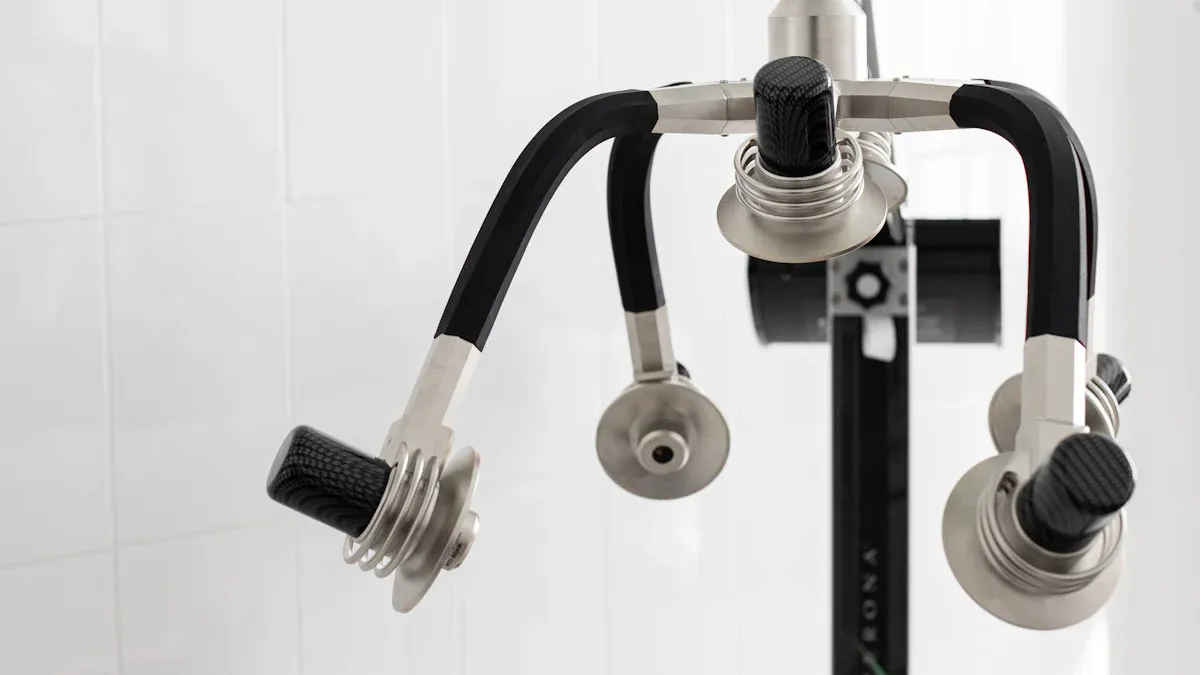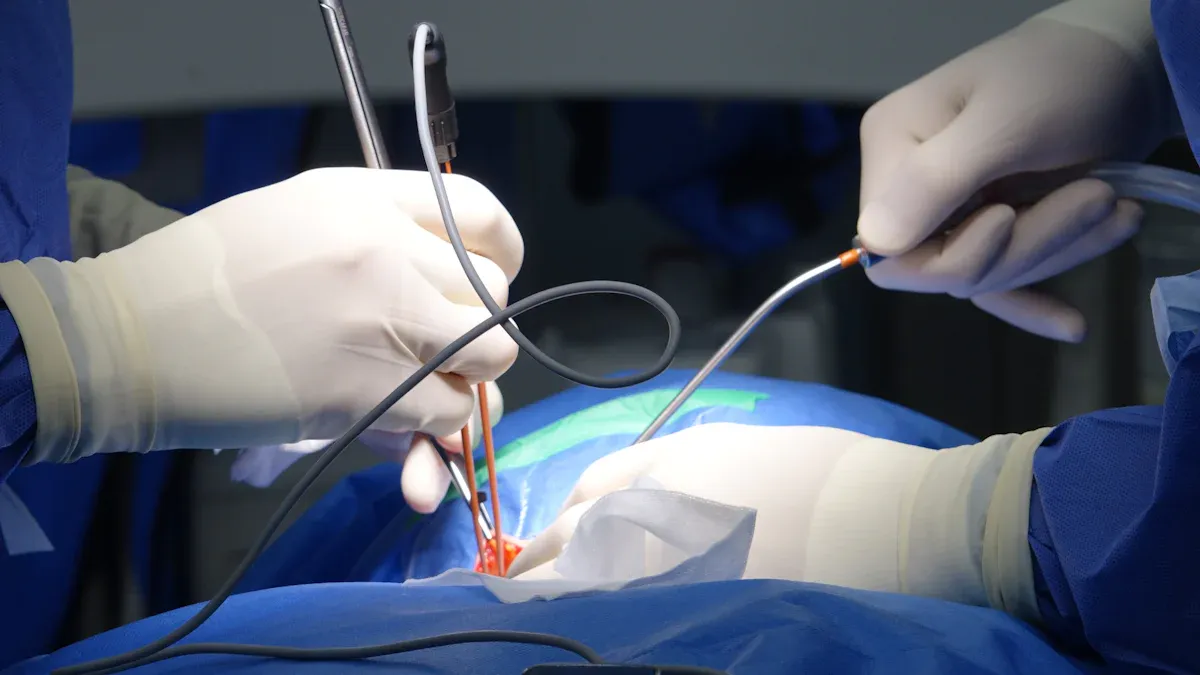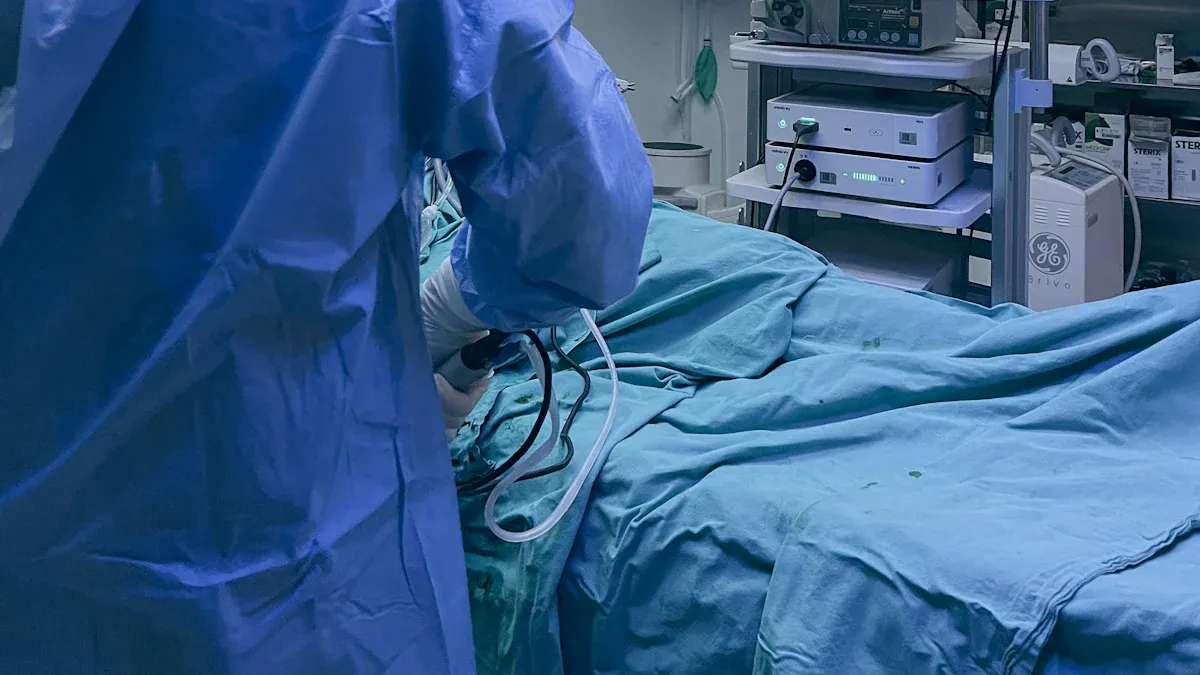Understanding PEEK Tubing for Minimally Invasive Surgery

Material selection plays a critical role in the success of minimally invasive surgery. You need components that ensure precision, safety, and long-lasting performance. This is where PEEK tubing excels. It offers unmatched strength, biocompatibility, and resistance to chemicals, making it ideal for surgical applications. With a high flexural modulus of 595,000 psi, PEEK ensures excellent pushability and prevents buckling, which is crucial for thin-walled instruments like endoscopes. Its low friction surface enhances precision, while its radiolucency avoids imaging artifacts. These properties make PEEK tubing for minimally invasive surgery an indispensable choice in modern medical procedures.
Key Takeaways
PEEK tubing is safe for the body, lowering surgery risks.
It can handle high heat, so it works well when sterilized.
Its smooth surface helps in surgery, causing less tissue harm.
PEEK tubing is light and bends easily, helping surgeons work better.
Using PEEK tubing lasts longer and saves money on replacements.
Key Properties of PEEK Tubing for Minimally Invasive Surgery

Biocompatibility and Patient Safety
When it comes to minimally invasive surgery, patient safety is paramount. PEEK tubing stands out as a biocompatible material, meaning it is well-tolerated by the human body. This reduces the risk of adverse reactions, such as inflammation or rejection, during surgical procedures. Its smooth surface minimizes friction, which helps protect delicate tissues from damage. For example, in endoscopy, PEEK tubing ensures instruments glide effortlessly, reducing the likelihood of injury to surrounding areas.
The use of PEEK tubing in surgical devices has been shown to enhance safety outcomes by lowering the risk of complications. This makes it an ideal choice for applications where precision and patient well-being are critical.
High-Temperature and Sterilization Resistance
PEEK tubing is renowned for its high temperature performance, making it suitable for demanding surgical environments. It can withstand elevated processing temperatures of up to 700 °F and maintains dimensional stability between 465 °F and 500 °F. This ensures that the tubing retains its shape and functionality even under extreme conditions.
Property | Value |
|---|---|
Elevated processing temperature | ~700 °F |
Dimensional stability range | 465 °F to 500 °F |
Melting point | 644 °F |
Sterilization methods | Gamma irradiation, ethylene oxide, thermal |
PEEK tubing is also autoclavable, meaning it can endure repeated sterilization cycles without degrading. Whether you use gamma irradiation, ethylene oxide, or thermal methods, PEEK ensures that surgical instruments remain sterile and safe for reuse. This durability under sterilization processes not only enhances safety but also contributes to cost efficiency by extending the lifespan of medical devices.
Chemical Resistance and Durability
The chemical and wear resistance of PEEK tubing makes it a reliable choice for minimally invasive surgery. It resists a wide range of chemicals, including diluted acids, bases, and hydrocarbons, ensuring long-term durability in various environments. For instance, PEEK can withstand exposure to up to 30% hydrogen peroxide, a common sterilizing agent, without compromising its integrity.
Chemical Type | PEEK Resistance |
|---|---|
Diluted Acids | High Resistance |
Concentrated Acids | Conditional Resistance |
Diluted Bases | Strong Resistance |
Concentrated Bases | Partial Resistance |
Aromatic Hydrocarbons | High Resistance |
Aliphatic Hydrocarbons | High Resistance |
Ethers | High Resistance |
Esters and Ketones | Strong Resistance |
Chloride-Based Solvents | Conditional Resistance |
Alcohols | High Resistance |
PEEK tubing also demonstrates exceptional longevity. It maintains its properties even when exposed to harsh chemicals or high temperatures. For example, it can endure 20-30% nitric acid for system passivation without degrading. This resilience ensures that PEEK tubing performs reliably over time, making it a preferred choice for medical tubing in critical applications.
Low Friction and Smooth Surface for Precision
Precision is critical in minimally invasive surgery, and PEEK tubing excels in this area due to its low friction and smooth surface. These properties allow surgical instruments to move effortlessly, reducing resistance during procedures. This is especially important when working with delicate tissues, as it minimizes the risk of accidental damage. For example, in catheter-based interventions, the smooth surface of PEEK tubing ensures seamless navigation through blood vessels, enhancing both safety and accuracy.
PEEK tubing's low coefficient of friction further validates its superior performance. Over time, the friction coefficient decreases with varying sliding speeds, demonstrating its ability to reduce wear and maintain efficiency. This unique characteristic stems from PEEK's chemical structure and mechanical strength, which contribute to its excellent wear properties. As a result, you can rely on PEEK tubing for consistent performance, even in demanding surgical environments.
Tip: The smooth surface of PEEK tubing not only improves precision but also reduces the force required to operate surgical tools. This can help reduce surgeon fatigue during lengthy procedures.
Lightweight and Flexible Design for Ergonomics
The lightweight nature of PEEK tubing makes it an ideal choice for minimally invasive surgical tools. Its reduced weight enhances the ergonomics of medical devices, making them easier to handle and control. This is particularly beneficial for surgeons who perform intricate procedures requiring steady hands and precise movements. Lightweight PEEK tubing ensures that instruments remain comfortable to use, even during extended surgeries.
Flexibility is another key advantage of PEEK tubing. Its ability to bend without breaking allows it to adapt to the complex anatomy of the human body. For instance, in endoscopic procedures, flexible PEEK tubing enables instruments to navigate tight or curved spaces with ease. This adaptability improves access to hard-to-reach areas, enhancing the overall effectiveness of the procedure.
The combination of lightweight and flexible design not only improves the surgeon's experience but also contributes to better patient outcomes. Instruments made with PEEK tubing can reach target areas more efficiently, reducing the duration of surgery and promoting faster recovery.
Benefits of PEEK Tubing in Surgical Applications
Enhanced Safety and Reduced Risk of Complications
PEEK tubing plays a pivotal role in improving safety during minimally invasive surgery. Its biocompatibility ensures that surgical instruments made with PEEK tubing are well-tolerated by the human body, reducing the risk of adverse reactions. The smooth surface of PEEK tubing minimizes tissue damage, which is critical when navigating sensitive areas like blood vessels or internal organs. You can rely on PEEK tubing to enhance patient safety by lowering the likelihood of complications during and after surgery.
The material's resistance to sterilization methods, including gamma irradiation and thermal processes, further contributes to improved safety. Instruments made with PEEK tubing maintain their integrity after repeated sterilization cycles, ensuring they remain sterile and reliable for reuse. This durability not only supports patient safety but also aligns with the goals of medical device manufacturers to produce long-lasting, high-performance tools.
Tip: Choosing PEEK tubing for minimally invasive surgery ensures improved safety outcomes, making it a preferred material for critical medical applications.
Improved Device Performance and Precision
PEEK tubing offers enhanced performance and precision, making it indispensable for minimally invasive surgical tools. Its chemical inertness and abrasion resistance ensure that devices maintain their functionality even under demanding conditions. For example, catheters made with PEEK tubing benefit from torsional stability, allowing precise navigation through complex anatomical pathways. This stability is crucial for procedures requiring high accuracy, such as cardiovascular interventions.
Key performance attributes of PEEK tubing:
High abrasion resistance for long-term durability.
Torsional stability for precise device control.
Superb sterilization resistance to maintain device integrity.
Low moisture absorption for consistent performance in medical environments.
PEEK tubing also exhibits excellent heat resistance, ensuring consistent performance in high-temperature settings. Its modulus, which closely resembles that of bone, makes it ideal for orthopedic applications. Whether you're designing vascular devices or spinal surgical tools, PEEK tubing provides the reliability and precision needed for successful outcomes.
Callout: PEEK tubing's enhanced performance and precision make it a top choice for medical device manufacturers seeking to innovate and improve surgical tools.
Versatility Across Various Surgical Procedures
The versatility of PEEK tubing allows it to be used across a wide range of minimally invasive surgical procedures. Its lightweight and flexible design make it suitable for applications requiring intricate movements and adaptability. For example, in endoscopic and laparoscopic surgeries, PEEK tubing enables instruments to navigate tight spaces with ease. Its chemical resistance ensures compatibility with sterilizing agents, making it ideal for reusable devices.
PEEK tubing also serves as an alternative to metals and other polymers, offering design flexibility for medical device manufacturers. Its ability to withstand high vacuum and pressure makes it reliable for critical applications, such as cardiovascular and neurological procedures. Additionally, its radiolucency avoids imaging artifacts, ensuring clear visualization during surgery.
Examples of surgical applications:
Catheters and guidewires for vascular interventions.
Endoscopic tools for gastrointestinal procedures.
Orthopedic implants for spinal surgeries.
Neurological devices for brain and nerve treatments.
Precision Tube & Catheter Inc. (PT&C) specializes in manufacturing high-quality PEEK tubing for minimally invasive surgery. Their expertise ensures that medical device manufacturers receive tubing tailored to meet the demands of modern surgical techniques. By choosing PT&C, you gain access to tubing that combines enhanced performance, improved safety, and unmatched versatility.
Long-Term Reliability and Cost Efficiency
When selecting materials for surgical tools, you need to consider their long-term reliability. PEEK tubing excels in this area, offering unmatched durability and consistent performance over time. Its ability to resist wear and maintain structural integrity ensures that medical devices remain functional even after repeated use. This makes PEEK an ideal choice for instruments that undergo rigorous conditions during minimally invasive procedures.
One of the standout features of PEEK tubing is its resistance to repeated sterilization cycles. Whether you use gamma irradiation, ethylene oxide, or autoclaving, PEEK retains its properties without degrading. This ensures that surgical tools made with PEEK can be reused multiple times, reducing the need for frequent replacements. Over time, this durability translates into significant cost savings for healthcare providers.
Note: PEEK tubing's longevity not only reduces costs but also minimizes waste, aligning with sustainable healthcare practices.
The chemical resistance of PEEK further enhances its reliability. It withstands exposure to harsh sterilizing agents and bodily fluids without compromising its structure. For example, PEEK tubing can endure contact with hydrogen peroxide or saline solutions, ensuring consistent performance in diverse surgical environments. This resilience makes it a dependable material for critical applications, such as cardiovascular and neurological procedures.
Key benefits of PEEK tubing's reliability:
Prolonged device lifespan due to wear resistance.
Reduced maintenance and replacement costs.
Consistent performance across various surgical conditions.
In addition to its reliability, PEEK tubing offers cost efficiency. Its lightweight and flexible design reduce manufacturing complexities, allowing medical device manufacturers to produce high-quality tools at a lower cost. Furthermore, the extended lifespan of PEEK-based instruments means fewer replacements, which helps hospitals and clinics save money in the long run.
Tip: By choosing PEEK tubing for your surgical devices, you invest in a material that combines durability, reliability, and cost efficiency, ensuring better outcomes for both patients and healthcare providers.
The long-term benefits of PEEK tubing go beyond financial savings. Its consistent performance and ability to withstand demanding conditions contribute to improved surgical outcomes. When you use tools made with PEEK, you can trust that they will deliver the precision and reliability needed for successful procedures.
Applications of PEEK Tubing in Minimally Invasive Surgery

Endoscopy and Laparoscopy Instruments
PEEK tubing plays a vital role in endoscopy and laparoscopy, two of the most common minimally invasive surgical techniques. Endoscopy relies on flexible instruments to navigate internal organs and tissues, while laparoscopy involves accessing the abdominal cavity through small incisions. PEEK tubing enhances these procedures by offering a lightweight, flexible, and durable solution. Its smooth surface ensures that endoscopy consumables, such as scopes and sheaths, glide effortlessly through narrow pathways, reducing tissue damage.
The material's radiolucency prevents imaging artifacts, ensuring clear visuals during endoscopic procedures. This clarity is crucial for accurate diagnoses and precise interventions. Additionally, PEEK tubing withstands repeated sterilization cycles, making it ideal for reusable endoscopy consumables. Its ability to maintain structural integrity under high temperatures and exposure to sterilizing agents ensures consistent performance in demanding surgical environments.
Catheters, Guidewires, and Vascular Devices
PEEK tubing is indispensable in catheter applications and vascular interventions. Its flexibility and torsional stability allow catheters and guidewires to navigate complex anatomical pathways with precision. This is particularly important in procedures involving delicate blood vessels, where accuracy is critical. The low friction surface of PEEK tubing minimizes resistance, enabling smooth device movement and reducing the risk of complications.
In addition to its mechanical properties, PEEK tubing offers excellent chemical resistance. It remains unaffected by exposure to bodily fluids and sterilizing agents, ensuring long-term reliability. Medical device manufacturers often choose PEEK for its ability to be extruded into microbore tubing and multi-lumen configurations, which are essential for advanced catheter applications. These design options provide superior performance compared to traditional materials, making PEEK tubing a preferred choice in vascular procedures.
Cardiovascular and Neurological Applications
Cardiovascular and neurological surgeries demand materials that combine strength, flexibility, and biocompatibility. PEEK tubing meets these requirements, making it a valuable component in devices used for these critical applications. In cardiovascular procedures, PEEK tubing ensures precise control of instruments, such as stents and balloon catheters, enhancing patient outcomes. Its lightweight design reduces strain on surgeons, improving ergonomics during lengthy operations.
In neurosurgery, PEEK tubing's ability to maintain dimensional stability under high temperatures and pressures is essential. It supports the development of advanced tools for treating conditions like traumatic brain injuries and spinal disorders. The material's radiolucency also ensures clear imaging during procedures, aiding in accurate device placement. With its unmatched durability and versatility, PEEK tubing continues to drive innovation in cardiovascular and neurological applications.
Spinal and Orthopedic Surgical Tools
Spinal and orthopedic surgeries demand materials that combine strength, flexibility, and biocompatibility. PEEK tubing has become a cornerstone in these procedures due to its unique properties. Its lightweight and durable nature makes it ideal for tools like spinal implants, orthopedic screws, and interbody spacers. These instruments require precision and reliability to ensure successful outcomes.
The smooth surface of PEEK tubing minimizes friction, which is crucial when working with delicate bone structures. Its ability to mimic the modulus of elasticity of human bone reduces stress shielding, promoting better integration with the body. This feature makes it a preferred choice for implants and trauma devices.
Several studies highlight the advantages of PEEK in spinal and orthopedic applications:
Steinberg et al. (2013) demonstrated the superior wear resistance and biomechanical properties of carbon fiber-reinforced PEEK composites in orthopedic trauma implants.
McGilvray et al. (2017) evaluated a PEEK-titanium composite interbody spacer in a lumbar fusion model, showing excellent biomechanical stability and bone integration.
Walsh et al. (2015) found that plasma-sprayed titanium coatings on PEEK enhance the bone-implant interface, improving surgical outcomes.
PEEK tubing also offers long-term reliability. It resists wear and maintains its structural integrity under repeated stress, ensuring consistent performance over time. Its chemical resistance allows it to withstand exposure to bodily fluids and sterilizing agents, making it suitable for reusable surgical tools.
Note: The use of PEEK tubing in spinal and orthopedic tools not only improves surgical precision but also enhances patient recovery by reducing complications and promoting faster healing.
By choosing PEEK tubing for spinal and orthopedic applications, you ensure that your surgical tools meet the highest standards of performance and safety.
PEEK tubing has revolutionized minimally invasive surgery by combining biocompatibility, durability, and precision. Its ability to withstand high temperatures, repeated sterilization, and chemical exposure ensures long-term reliability. These properties make it ideal for medical devices that demand consistent performance and patient safety.
The material's lightweight and flexible design enhances surgical precision while reducing complications. Studies highlight its advantages over other materials, such as its ability to handle tighter bend radii without breaking and its low friction, which prevents heat buildup during procedures. These features contribute to faster recovery times and improved patient outcomes.
Looking ahead, the global demand for PEEK in medical applications is expected to grow significantly. Its versatility and strength position it as a key material for future innovations in implants, vascular devices, and other surgical tools. By choosing PEEK tubing, you invest in a solution that supports both current and future advancements in minimally invasive surgery.
FAQ
What makes PEEK tubing better than traditional materials for surgical tools?
PEEK tubing offers superior biocompatibility, chemical resistance, and durability compared to metals or other polymers. Its lightweight and flexible design enhances precision and ergonomics. Additionally, it withstands high temperatures and repeated sterilization cycles, ensuring long-term reliability for minimally invasive surgical tools.
Can PEEK tubing be used in reusable surgical instruments?
Yes, PEEK tubing is ideal for reusable instruments. It resists wear and maintains its properties after multiple sterilization cycles, including autoclaving and gamma irradiation. This durability ensures that surgical tools remain safe, sterile, and effective for repeated use.
Is PEEK tubing safe for patients with metal allergies?
Absolutely! PEEK tubing is metal-free and biocompatible, making it a safe alternative for patients with metal allergies. Its inert nature minimizes the risk of adverse reactions, ensuring patient safety during and after surgical procedures.
How does PEEK tubing improve surgical precision?
PEEK tubing’s low friction and smooth surface allow instruments to move effortlessly, reducing resistance during procedures. This enhances control and accuracy, especially in delicate surgeries like endoscopy or vascular interventions. Its lightweight design also reduces surgeon fatigue, further improving precision.
What sterilization methods are compatible with PEEK tubing?
PEEK tubing supports multiple sterilization methods, including gamma irradiation, ethylene oxide, and autoclaving. It retains its structural integrity and performance after repeated cycles, making it a reliable choice for surgical tools that require stringent sterilization.
Tip: Always follow the manufacturer’s guidelines for sterilizing PEEK-based instruments to ensure optimal performance.
See Also
The Importance of Nitinol Tubing in Minimally Invasive Surgery
The Significance of Etched PTFE in Minimally Invasive Techniques
Key Uses of Ultrathin-Wall PET Heat Shrink Tubing in Medicine
Investigating Nitinol Tubing Uses in Medical Healthcare Equipment
Nitinol Tubing's Impact on Transforming Medical Device Technology

